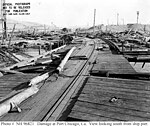Freeman Island (California)
Islands of Northern CaliforniaIslands of Solano County, CaliforniaIslands of Suisun BayIslands of the San Francisco Bay AreaSan Francisco Bay Area geography stubs

Freeman Island is a small island in Suisun Bay, California. It is part of Solano County. It is also known as Holbrook Island. Its coordinates are 38°04′46″N 121°59′09″W. Freeman Island is a popular spot for fishing; in 2019, a 53-inch sturgeon was caught near the island.
Excerpt from the Wikipedia article Freeman Island (California) (License: CC BY-SA 3.0, Authors, Images).Freeman Island (California)
Geographical coordinates (GPS) Address Nearby Places Show on map
Geographical coordinates (GPS)
| Latitude | Longitude |
|---|---|
| N 38.079444444444 ° | E -121.98583333333 ° |
Address
California, United States
Open on Google Maps










